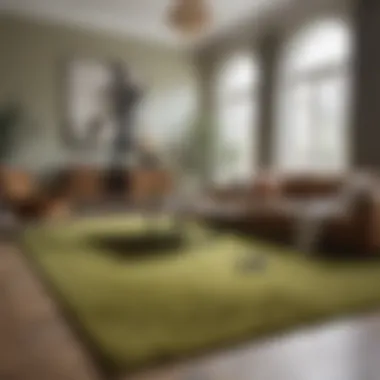The Timeless Appeal of Olive Colored Rugs in Design


Intro
When one thinks of interior design, color often takes center stage. Olive green, a hue that sits somewhere between yellow and green, has been quietly asserting its elegance in spaces big and small. This shade speaks of nature, evokes feelings of calmness, and provides a unique backdrop for a variety of aesthetics. Incorporating olive colored rugs can truly transform a room, but it requires an understanding of style, functionality, and the nuances of color.
Olive rugs can hold their own in a spectrum of design choices, from the ultra-modern to the more classic styles. They don’t just sit pretty on the floor but play a significant role in defining the narrative of your interior. This article will delve into how these rugs can be an asset in your home, covering color theory, styling tips, and practical care instructions, ensuring you make the best choices for your space.
"Colors are the smiles of nature." – Leigh Hunt
In the sections that follow, we’ll explore how to harmonize olive rugs with your chosen furniture styles, what trends are shaping the 2023 landscape, and practical tips for maintaining your rug to ensure it lasts through the years.
Understanding Olive Color in Design
In the realm of interior design, colors hold more weight than merely being aesthetic choices; they evoke feelings, set moods, and convey messages. Understanding olive as a color in design is paramount for any homeowner or designer looking to create spaces that resonate warmth and elegance. This section aims to peel back the layers of olive's significance and reveals why integrating this unique hue into one's decor can be a game changer.
The Color Olive: A Brief Overview
Olive, residing in the middle ground between green and brown, derives its name from the olive fruit. It carries earthy connotations but also reflects growth and stability—traits we often seek in our homes. What truly sets olive apart is its versatility; it’s not a color that screams for attention, yet it possesses an understated charm that can elevate any space. Mixing vibrant shades with olive can bring a refreshing balance, while softer tones can inspire a soothing ambiance.
The Emotional Impact of Olive in Spaces
Colors aren’t simply visual experiences—they are emotional catalysts. Olive, for example, often instills a sense of calmness and serenity within a space. The rich, muted quality can evoke feelings of nostalgia or comfort, much like sitting under a sprawling tree in a quiet park. When olive takes center stage in a room, it creates a more grounded atmosphere.
- It encourages relaxation, making it ideal for living rooms or bedrooms.
- It can also stimulate conversation when paired with other vibrant colors, enhancing your social spaces.
So, inviting olive inside is like bringing a little slice of nature along with it.
Olive and Color Theory: Harmonizing with Other Tones
Delving into color theory, olive proves to be a harmonizer. Its depth allows it to blend beautifully with a range of other colors. For instance, pairing olive with gold or brass accents can infuse a sense of luxury without being overbearing. Here is a quick breakdown of color combinations that work well with olive:
- Neutrals: White, beige, and grey enhance olive’s earthy tones, creating a tranquil backdrop.
- Warm Tones: Soft reds and oranges can contrast against olive, providing warmth and vibrancy.
- Cool Tones: Blues and teal bring a refreshing touch, while still allowing olive to maintain its significance.
Understanding these combinations can significantly influence how olive enriches a space. It’s not just about choosing a color; it’s about orchestrating a relationship between shades that leads to a visually cohesive and emotionally resonant environment.
"Colors, like features, follow the changes of the emotions." - Pablo Picasso
In summary, navigating the world of olive in interior design is an enriching journey. Recognizing its emotional weight, versatility in color pairings, and subtle undertones can empower any homeowner or designer to harness its full potential.
Types of Olive Colored Rugs
Understanding the types of olive colored rugs is crucial for homeowners and designers who want to seamlessly incorporate the unique hues of olive into their spaces. These rugs not only serve as stylish decor but also contribute significantly to the overall ambiance and functionality of a room. Choosing the right type of rug can enhance aesthetics, anchor a room, and provide comfort underfoot. From the idea of natural versus synthetic fibers to the craftsmanship involved, each category comes with its own considerations and benefits.
Natural Fibers: Wool, Jute, and More
When it comes to natural fiber rugs, wool and jute steal the show, especially in shades of olive. Wool, known for its durability and softness, adds a touch of warmth to the floor. The earthy tones found in wool rugs can deepen the inviting feel of a space. Moreover, these rugs often resist staining and are quite resilient, making them an ideal choice for high-traffic areas.
On the other hand, jute brings an entirely different aura to a room. Its rough texture and organic look provide an understated charm that complements rustic and bohemian interiors. Olive-colored jute rugs evoke nature, anchoring the serene vibe many homeowners seek. They are eco-friendly, which makes them appealing to those looking to minimize their ecological footprint. Just remember, jute can be a little less soft than wool, so it's best suited for spaces where comfort isn't the top priority.


Furthermore, there are other natural fiber options like sisal and cotton, which have their own qualities and can be dyed various shades of olive. They add versatility and help achieve a layered look.
Synthetic Options: Pros and Cons
Synthetic rugs made from materials such as polypropylene or nylon can be a cost-effective way to bring olive colors into your home. One key advantage is their resistance to fading, which ensures that the vibrant olive hue remains intact even in sunlit areas. Additionally, synthetic rugs are often easier to clean, making them an ideal choice for homes with children or pets.
However, one must consider the environmental impact of synthetic materials. While they can mimic the look of natural fibers closely, they may not provide the same warmth and texture. The breathability of materials like wool cannot be matched by most synthetic options, potentially leading to a less cozy atmosphere.
In summary, if you're aiming for something low-maintenance without going for the natural feel, synthetic rugs could work wonders. But, do weigh the environmental impacts against the benefits.
Handmade vs. Machine-Made Rugs
The choice between handmade and machine-made olive colored rugs can be a pivotal moment in your design journey. Handmade rugs often boast a unique character that machine-made options simply cannot replicate. Each piece tells a story through its imperfections and variations in color and texture. When opting for a handmade rug, the cost may be higher, but consider it an investment in artistry.
In contrast, machine-made rugs offer the convenience of uniformity and affordability. They often come with quicker availability and easier upkeep, generally making them more accessible to the wider audience. However, they may lack the depth and the artisan quality that speaks to individuality.
Ultimately, the decision comes down to your personal preferences, lifestyle needs, and budget. Whether you lean toward craftsmanship and uniqueness or the ease and practicality, both options offer their own distinct appeals.
The right choice of rug can set the stage for the room, influencing mood and comfort.
Incorporating Olive Colored Rugs into Design
The inclusion of olive colored rugs within interior design is essential for both aesthetic appeal and the creation of a welcoming atmosphere. These rugs not only serve as functional floor coverings but also as pivotal elements that enhance the overall design narrative of a space. Utilizing olive tones can evoke feelings of tranquility and connection with nature, acting as a subtle reminder of the outdoors in the comfort of one’s home.
Olive rugs can help in establishing a foundation in a room, guiding the selection of colors and materials for other design elements. When incorporating these rugs, it is important to consider their placement and the surrounding visuals. The harmonious integration of olive rugs can effectively draw the eye, allowing for a seamless flow throughout the space.
By incorporating olive colored rugs into a design scheme, one can:
- Enhance the color palette through thoughtful pairings.
- Create versatile backdrops suitable for various themes.
- Introduce depth and variety to the overall texture of the room.
Creating Focal Points in Rooms
An olive colored rug can act as a focal point in any room, directing attention to a particular area of interest. For example, in a living room, positioning a deep olive rug beneath a coffee table generates a sense of grounding and cohesion. This combination serves as a visual anchor that can tie in other design elements, such as decorative pillows and artwork.
Choosing a bold patterned olive rug may further elevate this aspect by creating a striking contrast against neutral furniture. A specific pattern, like geometric shapes or floral prints, can also complement existing decor, effectively enhancing the space’s overall character.
Layering Textures for Depth
Layering textures is another robust strategy in which olive colored rugs play a key role. By combining various textiles and materials, one can achieve rich visual interest and depth in a room. For instance, pairing a plush olive rug with a woven jute mat offers a beautiful contrast that draws the eye and enriches the sensory experience.
Incorporating different materials, from silk cushions to cotton throws, alongside the olive rug can amplify the cozy feeling of a space. Additionally, using a matte finish on walls can offset the glossy nature of some rugs, creating a balanced look.
Combining with Different Styles
Modern
In modern design, the simplicity and clean lines are highly valued. The olive color can contribute to this style by bringing in natural elements without overwhelming the minimalist aesthetic. A solid or subtly patterned olive rug can ground a modern space by complementing neutral tones and sleek furniture.


Its unique feature lies in its adaptability; olive pairs seamlessly with shades of gray and accents of brass or gold. However, one must be cautious with bold patterns as they might disrupt the straightforward vibe typical in modern rooms.
Rustic
Rustic design is characterized by its warmth and use of natural materials. An olive rug suits this style perfectly by echoing the earthy tones present in wooden surfaces and stone features typically found in rustic décor. Its key characteristic is its connection to nature, creating a warm ambience that makes a home feel inviting.
Notably, olive rugs can have more textured weaves, adding to the organic feel throughout the space. While this combination is beloved, it’s essential to ensure that the rug’s texture doesn’t clash with other materials, which could potentially create a visual disconnect.
Contemporary
Contemporary design thrives on innovation and current trends, making olive rugs a fitting choice for this style. The adaptability of olive as a hue allows for creative expressions, blending with vibrant colors or stark blacks and whites.
In contemporary settings, an olive rug with striking patterns can serve as a statement piece, elevating the design while remaining grounded. The trick is to match or contrast the rug with bold artwork or modern furniture to maintain a harmonious balance. Remember, though, that being trendy comes with the need for frequent updates, and selecting a timeless olive design can help keep your decor feeling fresh without frequent changes.
"Utilizing earth tones like olive can create a calming yet sophisticated atmosphere that appeals to many design sensibilities."
Ultimately, incorporating olive colored rugs into the fabric of a home is more than just placing an item on the floor; it’s about crafting an environment that resonates with comfort, style, and personality.
Styling Tips for Olive Colored Rugs
When drawing up a plan for interior design, it’s vital to keep in mind the way rugs can alter or enhance a space, especially those in olive tones. These rugs serve as more than just floor coverings; they act like a canvas, setting the overall vibe in any room. With the right styling approach, you can augment the aesthetic appeal and functional nature of olive colored rugs, ensuring they play nicely with your overall design schemes.
Choosing Complementary Furniture
Picking furniture that complements olive colored rugs whill can be a tricky business, yet once done right, it can elevate the ambiance of the space tremendously. Sofas and chairs in neutral colors like beige or gray tend to work beautifully, allowing the rug to stand out without overwhelming the room. Softer fabrics such as linen or cotton in these neutral hues also make the space feel cozy.
Another angle is to introduce a few pieces in rich earth tones such as terracotta or deep browns. This adds depth and creates a harmonious flow with the olive green undertones. Also think about the style; a rustic wooden bench or mid-century modern chair can really make the olive rug sing in a living space.
Accessorizing the Room Effectively
Cushions
Cushions are like the cherry on top of your interior design cake. When they’re paired well with olive rugs, they can tie the whole room together. Patterns that feature earthy hues or nature-inspired designs can enhance the color story without clashing. What’s key here is the texture; choose cushions with varied materials like velvet, cotton, and wool. This variety can create an inviting space that begs you to sink back into the couch. Burnt shades mixed with olive bring warmth and comfort, a balance worth aiming for.
Artwork
Art can be the crowning glory of any room, helping to solidify the ambiance you aim to achieve. Laying artwork against a backdrop of olive rugs opens the door for a multitude of creative expressions. Consider pieces that pick up on the greens, such as abstract prints or landscape scenes. The vibrant colors contrast beautifully with the earthiness of the olive tones, fostering a connection between elements in the design. One thing to remember is that larger pieces can often anchor a space, providing a focal point that draws the eye while smaller pieces can be more about accents.
Lighting
Lighting can make or break the vibe of a room. With olive colored rugs, make sure that your lighting choice accentuates the natural warmth of the olive tones. Soft, warm-toned bulbs create an inviting atmosphere. Overhead fixtures like pendant lights can cast unique shadows and highlights onto the rug, enhancing its texture. A statement lamp positioned strategically can also create an interesting interplay between light and dark, emphasizing the rich palette at play.
Incorporating Natural Elements
Accessorizing does not stop at cushions and art; bringing in elements from nature can amplify the overall look and feel.
Plants


Plants breathe life into any space. Pairing olive rugs with greenery can add a layer of freshness that’s simply unparalleled. Think of small pots with succulents or larger plants like rubber trees that stand tall against the olive hue. The contrast is eye-catching, creating a serene, grounded space. Additionally, the different shades of green can collaborate beautifully, softening the overall look and making the room feel more organic.
Wooden Accents
Lastly, wooden accents serve as the cherry on top when adding character to a design scheme featuring olive rugs. Furniture, side tables or even decorative pieces with a rustic finish can create a warm environment. The nature of wood brings a tactile quality that works well with the soft fibers of a rug. Just like the complements in furniture, balance is important here too; stick with pieces that either contrast or match closely with the olive tones, letting them create a harmonious blend.
By weaving together these elements thoughtfully, you're set to achieve a stylish and comfortable interior that respects the natural charm of olive colored rugs.
Maintenance and Care for Olive Colored Rugs
Maintaining and caring for olive colored rugs is essential for sustaining their charm and integrity over time. Given that these rugs not only contribute to the aesthetic of a room but also face daily wear and tear, understanding how to properly care for them can extend their lifespan significantly. In this section, we’ll detail the importance of routine maintenance, key approaches for cleaning, and understanding when it might be best to call in professionals for assistance.
Olive colored rugs, with their rich and earthy tones, can bring warmth to any space. However, just like any textile, they’re prone to gathering dust, spills, and even fading from sunlight. By following straightforward maintenance and care practices, homeowners can keep their rugs looking fresh and vibrant.
Cleaning Techniques for Various Materials
When it comes to cleaning, the specific material of the rug plays a pivotal role in determining the best techniques to use. Different materials require distinct care methods, so understanding what you’re working with is crucial. Here are some widely used methods based on common rug materials:
- Wool Rugs: Vacuum regularly to prevent dirt accumulation. For stains, gently blot with a damp cloth and a mild detergent.
- Synthetic Rugs: These are often more durable and can frequently be cleaned using soap and water. Some are even machine washable.
- Jute and Natural Fiber Rugs: Vacuum regularly, but avoid soaking them in water. If stains occur, use a damp cloth to blot and clean.
"Regular maintenance not only keeps your rug looking good but helps prevent more serious damage down the road."
Preventing Fading and Wear
To enjoy the beauty of olive colored rugs for years to come, one must consider strategies for preventing fading and wear. Here are some practical tips:
- Use Rugs in Low-Traffic Areas: While it’s tempting to showcase a stunning olive rug, consider placing it in areas where traffic is limited to reduce wear.
- Rotate Regularly: If the rug is in a high-use zone, rotating it every few months can help ensure even wear.
- Avoid Direct Sunlight: Placing the rug away from direct sunlight can prevent the rich hues from fading. You might want to consider using window treatments.
Beyond these measures, ensuring a clean and ventilated environment will minimize dust and grime buildup, further protecting the color integrity and texture of the rug.
When to Seek Professional Help
There are moments when self-cleaning might not cut it, and knowing when it's time to call in professionals is crucial. Here’s when you should consider professional services:
- Deep Stains: If you've encountered a tough stain that simply won’t budge with home remedies, it may be wise to involve a professional cleaner.
- Severe Wear: For rugs that are showing signs of significant wear or damage, upholstery or rug specialists can provide the necessary repair or restoration works.
- Annual Deep Cleaning: Even if the rug looks fine, an annual professional cleaning can be beneficial in maintaining the fabric and color without impacting its structure.
Closure: Embracing Olive Colored Rugs in Your Home
In the grand tapestry of interior design, choosing the right elements can transform a space from ordinary to extraordinary. Olive colored rugs, with their distinct hue, hold a unique position in this narrative. They are not just floor coverings; they are conversation starters, statement pieces, and bringers of warmth.
One glaring advantage of incorporating olive rugs is their versatility. This shade complements a plethora of designs, from modern minimalism to rustic charm. It blends seamlessly, making it suitable for various settings. For instance, placing an olive rug in a contemporary living room can soften the stark lines of furniture, creating a balanced and inviting atmosphere. Conversely, in a rustic setting, it can enhance the natural tones, adding richness without overpowering the overall aesthetic.
The emotional resonance of olive green cannot be overstated. This color evokes feelings of tranquility, nature, and renewal. It brings a slice of the outdoors inside, making spaces feel fresher and more alive. Homeowners, designers, and DIYers should keep in mind how the presence of olive hues can shift the mood of a room. For some, it might encapsulate the calm of a forest, while for others, it could signify growth and possibility—much like the olive tree itself.
"The beauty of olive rugs lies in their ability to adapt and flourish in varied surroundings. They embody elegance and practicality, functioning as both art and utility in home decor."
Consideration also comes into play with maintenance. Olive rugs, especially from natural fibers, may require attention to keep them looking their best. Proactive care, routine cleanings, and mindful placement can ensure longevity. Homeowners should be well-informed about the materials they choose, recognizing that some types may resist fading more than others, maintaining that lush olive hue over time.
Additionally, when anyone is ready to embark on a decorating journey with olive colored rugs, a few simple guidelines can make a significant difference. Pairing them with appropriate accessories, like muted lighting or textured cushions, can heighten their effect. Rather than clashing with bold colors, olive can enhance subtler palettes, offering a striking yet understated elegance.
In this age of personalized spaces, embracing the unique charm of olive colored rugs can add an additional layer of depth and sophistication. Whether you're looking to revamp an existing room or start anew, consider how olive hues can anchor your design and bring a sense of harmony, depth, and life.
Moreover, in a world where design evolves perpetually, staying attuned to color trends and selecting elements that stand the test of time is paramount. Olive rugs are not just a fleeting trend; they are a timeless choice that aligns with today's eco-conscious philosophies too, reflecting nature's inherent beauty and inviting it right into our homes.
In summary, olive colored rugs are more than just aesthetic additions; they are integral to creating spaces that feel cohesive, inviting, and meaningful. By thoughtfully integrating them into interior design, you not only enhance the beauty of your home but also enrich your living experience, fostering an environment that resonates not only with style but also with a sense of tranquility.







